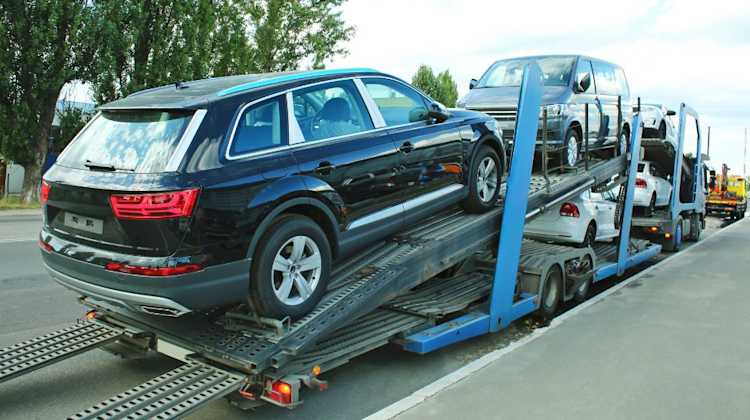PCS Q&A: Managing Delivery Day Expectations
by PCSgrades Staff - June 28th, 2021

DoD Updates: This year we are facing issues with the labor shortage, so if you have questions, always reach out to your Move Coordinator first. They are contracted through your TSP (Transportation Service Provider). If you are having trouble getting hold of them, reach out to your local transportation office so they can take action. If you have orders to move this summer, know that most moving companies are booked through July and into August, so srt up your move on DPS as soon as possible. Make alternative plans, consider a PPM, split travel, or even putting your things into storage and letting the military pick up from there. Use our group Lost During My PCS to stay connected and ask your moving questions.
What do you do to prep your mostly empty home before movers arrive?
Before your items arrive, if you have been “house-camping” then put those items away or clear them out of the rooms. Deflate air mattresses, put suitcases into closets, consider putting things back into your car, etc. This gives the movers space to unpack.
Next, have an idea how you want each room set up, where you want furniture to go. They will re-assemble large furniture, but it will be a one-time placement. When you do the walkthrough with movers, tell them which wall is for beds, what large furniture goes next to a window, etc. Then they won’t stack boxes where all the furniture needs to go.
Use room labels with bright-colored stickers. If your boxes are already labeled with a colored sticker, then using the same color on the sign makes it easy to assign boxes. Tape a list to each room doorway listing what goes in each room. “White dresser, pink chair, pink mirror,” etc. Then they can easily glance at each paper and see where each piece of furniture needs to go. Then you don’t have to spend so much time directing traffic. This gives you more time to look at inventory and check off the correct boxes as they come off the truck.
Do we have to open each box while the movers are there?
No, you don’t have to open each box, but you will need to check it off and verify that you received it on the main inventory sheet. So it is wise to peek inside each box and verify contents. But you do have 180 days from delivery day, unless they are high-value items. The High-Value Inventory form MUST be signed on delivery day, so you must open and inspect that they are there. And if it was a non-temp storage shipment you only have 75 days to file a claim.
It is always important to open up every single box within those 180 days, even if it’s an old box of odds and ends that has been sitting around forever. You don’t know if the movers threw anything else in that box, or if something is lost or broken, so please be sure to open every box within that time frame.
Do we need the moving crew to stick around while we set up electronics?
You don’t have to plug them in and get the whole system working, but make sure you note on the form that you received the item but didn’t set it up yet. You do need to verify that each high-value electronic was received, and any visible damage on the outside should be noted. If you later discover that there was some internal damage or things are not working properly, you will need to get a letter written by a tech repair expert to verify that the damage most likely happened in transit and was caused by movement, rather than a faulty piece or something that has ceased working naturally. But yes, you can plug in electronics on Move In Day to verify whether or not they work, and note any damage or observations on the inventory sheet.
What needs to happen with the high-value inventory?
It may be useful to gather all high-value items in one place BEFORE the move so that they are all packed together. Use your dining room for space to gather and then inspect them. Since all high-value items need to be opened and inspected on the day of delivery, they should again be delivered to the dining room so you can open everything in one place and check for any damages. Don’t feel bad about making the crew wait while you inspect china or crystal or collectables. It is your job to unwrap and note any potential damage to these high-value items BEFORE you sign the high-value inventory form. Tell them to take break time, or they are available to stand there and help unwrap. It is required to inspect items, so don’t feel bad about taking that time. If you haven’t plugged in electronics, just note it on the form that they were received, but that you haven’t yet plugged them in to assess if they work.
Where can we find the rules for high-value items?
It’s in the DTR (Defense Travel Regulations), starting on page 13. Anything that is worth more than $100 per pound can be listed as a high-value item, according to the regulations. Some companies are saying that individual items must have a serial number or a specific dollar value, or that it needs antique paperwork. That is incorrect. It does not need a serial number or a high value per item. But it is always recommended to have an appraisal value for any antiques or collectables so you can demonstrate their value and this can be used as paperwork for a claim.
During delivery day, what should we be doing?
Someone needs to stand near the truck to check off inventory numbers as items come off the truck. Either set up near the front door or the garage. You need to check off each box so you can identify if there are any boxes missing at the end of the day. Before you sign the form at the end of the day, you should be able to account for each box. Sometimes one number gets missed, and the entire crew has to search for it.
There are generally two inventory sheets. One is for boxed items, the other is for furniture items. They will sometimes have different colored labels stuck on the furniture with the inventory and lot number. The lot number is small, listed above the inventory number. They will read off things like “Yellow 17” or “Blue 23” as they pull things off the truck, and you need to check them off as they go into the house. There may be a third color if they ran out of a roll and had to switch.
You also want to walk through the house occasionally and check that major furniture pieces are placed approximately where they need to go and ending up in the right room. If boxes are getting stacked along a wall where you need to assemble a bed later, let them know before the box pile gets too big so they can plan accordingly. Some people use a highlighter to check off the inventory number as it is called out. Other people use a Bingo sheet style of colors and numbers. Other people use a blank sheet of paper to write down each number called out, then during a water break they compare notes to the official inventory sheet to make sure they don’t accidentally mark something off. If something is missing a number, set it aside and you can check at the end of the day what is missing on that section of inventory to match it up to the item missing the tag or label.
At the end of the paperwork, what do you need to note for lost or damaged items?
There is another form called “Lost or Damaged at Delivery.” If box #37 never showed up, write that box 37 was missing. If a piece of furniture is noticeably damaged, write “Item #218 is cracked and broken.” You do have 180 days to discover damage and file a claim, but it is always easiest and quickest to get a claim settled if you note it on the delivery paperwork.
What are some good unpacking strategies for the movers to use?
You CAN request the movers do an unpack. They should remove the items from the box, and place them–only one time– on the nearest clean, flat surface. This can be a cabinet, shelf, set up table, etc. They should not be just dumping things out on the floor. They will unpack until they have no more space to unpack. So you need to be heavily involved in the process. Throw things into kitchen cabinets as they place them on the counter so that they have more space to continue unpacking. They are not going to set up your house and organize things for you, set up a collection in a specific order, etc. They will place books on a designated shelf or put mugs in a specific cabinet, but you will want to go back and arrange them later according to your own preferences.
We usually do a partial unpack. Of course we open and unpack the high-value items. I do have them partially unpack the kitchen, starting with the boxes that have dishes, silverware, bakeware, and cookware. This lets me start cooking again as soon as possible. Our wardrobe boxes get unpacked because it is easy to open them and place hangers on the rod in the closet. We have a lot of books, which get unpacked and placed in a corner or on a shelf. That way, all these large boxes can be disposed of and cleared away by the movers before they leave for the day. I do a lot of pre-packing and placing items in large Ziploc containers, so my emphasis is on getting the cardboard boxes out of the house.
If you prefer to clean dishes during unpack, open up the dishwasher and place everything directly in there so dishes can be immediately washed. You can also wrap a silverware container in plastic wrap so no dirt and dust gets into them during the move. Then you can just cut off the plastic and know they are ready to go.
What is an inconvenience claim and when do you become eligible if a delivery is missed?
If they can’t deliver to you within a certain amount of time, you can be eligible for an inconvenience claim. It has to be a reason within the TSP’s control. If they overbooked, that is their fault. If there is a hurricane that delays the delivery date, that is an “act of God” and will not make you eligible.
There are two ways you can be paid. The first is for the service-member only to get a per diem for each day of the delay. This is good for families who “house camp” and already have things like sleeping bags, air mattresses, and some basic cooking supplies.
The second method is for you to get certain essential items per person and submit receipts to claim a reimbursement for your expenses. It is things like 1 towel, sheet set, pillow, and cheap air mattress per person, plus some basic cooking essentials. These must be store-brand basic items for reimbursement.
If items were placed in storage without notifying you, or it is not within 7 business days of the original requested delivery date, then you qualify for an inconvenience claim. If you call more than 7 days in advance and the TSP is not able to deliver within 2 days of that requested date, then you may be eligible for a claim.
What if the movers damage the home while moving furniture in?
These are called Real Property Damage. You have 7 days to file a claim for that damage directly with your TSP. They have tried to simplify this process so the TSP can work with the local agent. This includes things like scratches or dents to walls, doorways, stairs, etc. File within 7 days of delivery. You can find the details on Move.mil through the Customer Service tab.
What do military families need to know about the delivery and unpack process?
Checking off your inventory numbers is probably the most important thing you do that day. Also check for any visible damage to items or property so you can note it immediately on the forms. Also, inspecting your high-value items is an important step for delivery day.
HOW DO YOU NOTE WATER DAMAGE ON A BOX OR PACKING MATERIALS?
Open it and check the condition of the items. If they are okay, still note it to your Move Coordinator, because they will want to know that the truck had a leak. If you open a box and there is mold, they must take those boxes and items back to the warehouse that day. They have to call a remediation company to go through the items and decide what can be cleaned or repaired. You should receive cleaned items delivered later to your home, or you will receive a list of items that are being cleaned and remediated.
Can I do a quick claim if I notice damage on moving day?
The moving company may offer you a Quick Claim on Moving Day if there is visible damage to a mattress or an essential item. This will be processed in 7 days to help you get back to a normal quality of life. However, unless it is something you need immediately, it is best to wait until you have checked all your items for other damage. Then you only have to file one claim and keep track of one claim timeline, instead of dealing with multiple claims and paperwork.
Are we required to keep damaged items until the claim is completed?
If your shipment was processed after May 15, 2021, the salvage rules have changed this year. The TSP now has 20 days to send an inspector to look at your items, then either 20 more days after the inspector’s visit and 45 days total after the claim was filed, to place a salvage claim on the property. This is for items that will not be repaired, when you are receiving a cash reimbursement to replace the broken item. Glass can be disposed of, but a mirror frame or other furniture should be saved to give the TSP an opportunity for their salvage rights. Families no longer have to get storage units for their broken furniture while waiting months for a claim to be settled.
Do we get partial or full replacement value from the military claims office?
The MCO pays a depreciated value up front, then they go after the TSP for full replacement value. Any additional monies they receive, they will then later send you another check to cover the difference.
Watch the full video of this webinar on our YouTube Channel here.







